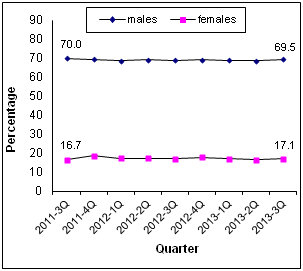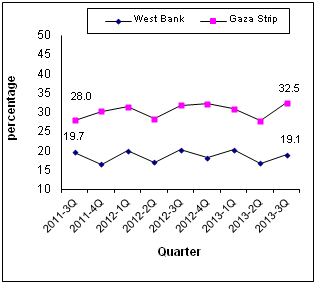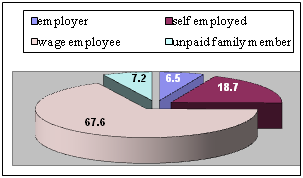Palestinian Central Bureau of Statistics (PCBS)
Press Release on the Results of the Labour Force Survey July- September 2013 Round Main Results
The labour force participation rate of persons aged 15 years and above was 43.6%
The number of persons participating in the labour force in Palestine was about 1.161 million in the 3rd quarter 2013:فىفاع فال; about 761 thousand in the West Bank and about 400 thousand in Gaza Strip.
The labour force participation rate in the West Bank was 44.9% and 41.4% in Gaza Strip, the gap in the participation rate between males and females still very big it reached 69.5% for males compared with 17.1% for females.
Labour Force Participation Rate by Sex, Q3-2011- Q3-2013

23.7% the unemployment rate among labour force participants
Using ILO standards, the number of unemployed was about 275 thousand in the 3rd quarter 2013: about 145 thousand in the West Bank and about 130 thousand in Gaza Strip.
The unemployment rate in Gaza Strip was 32.5% compared with 19.1% in the West Bank, and the unemployment rate for males in Palestine was 20.3% compared with 37.8% for females.
Unemployment Rate by Region, Q3-2011- Q3-2013

The highest unemployment rate in the 3rd quarter 2013 was 43.1% among youth aged 20-24 years. For years of schooling, the unemployment rate among females with 13 years of schooling or more was 49.9%.
The highest unemployment rates in the West Bank governorates was in Hebron with 22.3%. In Gaza Strip, the highest unemployment rate was in Khan Younis with 35.8%.
According to the relaxed definition of unemployment in Palestine, the unemployment rate increased from 24.5% in the 2nd quarter 2013 to 27.1% in the 3rd quarter 2013.
decreased the number of employment in the local market between the 2nd quarter 2013 and 3rd quarter 2013
The number of employed in the local market decreased from 801 thousand in the 2nd quarter 2013 to 780 thousand in the 3rd quarter 2013. The number of employed persons in the West Bank decreased by 12 thousand, while the number of employed persons in Gaza Strip decreased by 9 thousands.
The services sector was the biggest employer in the local market with 33.6% in the West Bank and 49.6% in Gaza Strip.
The public sector employed 22.9% of those in employment: 36.2% in Gaza Strip and 17.1% in the West Bank.
The average daily wage for waged employees in the West Bank was 88.3 NIS compared with 59.3 NIS in Gaza Strip.
The average weekly hours worked by waged employees in the West Bank was 44.2 per week in the 2nd quarter 2013 compared with 43.3 in the 3rd quarter 2013. The average number of days worked per month decreased from 22.7 to 22.3 over the same period. The average number of hours worked per week in Gaza Strip was 39.1 hours per week in the 2nd quarter 2013 compared with 38.0 in the 3rh quarter 2013, while the average number of days worked per month increased from 23.5 to 23.8 days over the same period.
Number of employed in Israel and Israeli settlements about 103 thousand in the 3rd quarter 2013
The number of employed persons from the West Bank employed in Israel and Israeli settlements increased from 96 thousand in the 2nd quarter 2013 to 103 thousand in the 3rd quarter 2013. Of these, 51,100 had a permit, 34,600 worked without a permit and 17,600 employed persons have an Israeli identity card or foreign passport.
The number of employees in Israeli settlements 20 thousand in the 2nd quarter and 3rd quarter 2013.
61.0% of employed in Israel and Israeli settlements work in the construction sector.
The average daily wage for persons employed in Israel and Israeli settlements increased from 172.1 NIS in the 2nd quarter 2013 to 178.9 NIS in the 3rd quarter 2013.
The average number of hours worked per week decreased from 43.0 in the 2nd quarter 2013 to 41.6 in the 3rd quarter 2013. The average number of days worked per month decrease from 19.9 in the 2nd quarter 2013 to 19.7 in the 3rd quarter 2013.
Employment status in the 3rd quarter 2013
67.6% of employed persons are waged employees: 65.9% in the West Bank compared with 71.6% in Gaza Strip.
18.7% of employed persons are self- employed; 18.8% in the West Bank and 18.5% in Gaza Strip.
7.2% of employed persons are unpaid family members: 8.2% in the West Bank and 4.7% in Gaza Strip.
6.5% of employed persons are employers: 7.1% in the West Bank and 5.2% in Gaza Strip.
Percentage Distribution of Employed Persons by Employment Status, Q3-2013

Working benefits for waged employees in the private sector
25.2% of waged employees are hired by contract, compared with 56.6% hired without a contract.
19.6% of waged employees contribute to a pension fund; 21.2% have annual paid leave; 43.6% of wage employees women have paid maternity leave.
30.1% of employed persons in Palestine are affiliated to a workers vocational union: 15.0% in the West Bank and 64.5% in Gaza Strip.
37.2% of wage employees in the private sector receive less than minimum wage in Palestine.
In the West Bank about 22.4% of wage employees in the private sector receive less than minimum monthly wage about 45,200 wage employees with average monthly wage 1,070 NIS. the large number of those who receive less the minimum monthly wage are in the north West Bank about 22,500 person with average monthly wage 1,051 NIS, followed by south West Bank governorates about 14,000 with 1,054 NIS.
In Gaza Strip the percentage of wage employees in the private sector was 68.4% about 65,300 wage employees with average monthly wage 824 NIS. the large number of those who receive less than minimum monthly wage are in north Gaza Strip about 37,400 person with average monthly wage 835 NIS, followed by middle Gaza Strip governorates about 20,800 with 832 NIS.
4.0% of children aged 10-17 years are employed
4.0% of children aged 10-17 years are employed: 5.7% in the West Bank and 1.3% in Gaza Strip.
Data collection of labour force survey was funded by the European Union.
 عربي
عربي